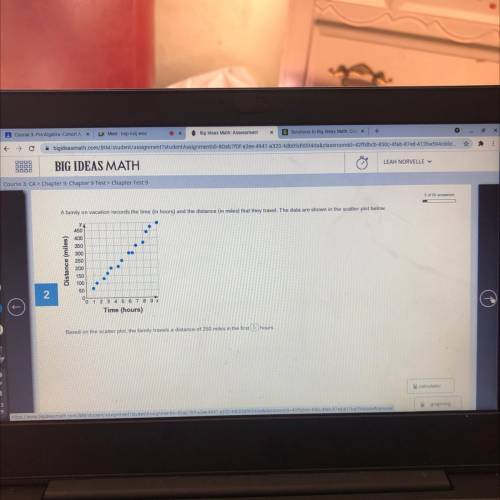
Mathematics, 11.05.2021 01:40 Jehovel
30
A family on vacation records the time in hours) and the distance (in miles) that they travel. The data are shown in the scatter plot below.
Distance (miles)
450
400
350
If you answer with a link I will report you and get your account blocked
300
250
200
150
100
50
2
0 1 2 3 4 5 6 7 8 9 X
Time (hours)
Based on the scatter plot, the family travels a distance
250 miles in the first 5 hours.


Answers: 2


Another question on Mathematics

Mathematics, 21.06.2019 13:30
If δmtv is reflected across the y-axis, what are the resulting coordinates of point m? a) (-2, 5) b) (-5, 2) c) (5, -2) d) (-2, -5)
Answers: 1

Mathematics, 21.06.2019 16:20
Browning labs is testing a new growth inhibitor for a certain type of bacteria. the bacteria naturally grows exponentially each hour at a rate of 6.2%. the researchers know that the inhibitor will make the growth rate of the bacteria less than or equal to its natural growth rate. the sample currently contains 100 bacteria.the container holding the sample can hold only 300 bacteria, after which the sample will no longer grow. however, the researchers are increasing the size of the container at a constant rate allowing the container to hold 100 more bacteria each hour. they would like to determine the possible number of bacteria in the container over time.create a system of inequalities to model the situation above, and use it to determine how many of the solutions are viable.
Answers: 1

Mathematics, 21.06.2019 17:00
In tossing one coin 10 times, what are your chances for tossing a head? a tail? 2. in tossing one coin 100 times, what are your chances for tossing a head? a tail? 3. in tossing one coin 200 times, what are your chances for tossing a head? a tail? deviation = ((absolute value of the difference between expected heads and observed heads) + (absolute value of the difference between expected tails and observed tails)) divided by total number of tosses. this value should always be positive. 4. what is the deviation for 10 tosses? 5. what is the deviation for the 100 tosses? 6. what is the deviation for 200 tosses? 7. how does increasing the total number of coin tosses from 10 to 100 affect the deviation? 8. how does increasing the total number of tosses from 100 to 200 affect the deviation? 9. what two important probability principles were established in this exercise? 10. the percent of occurrence is the obtained results divided by the total tosses and multiplied by 100%. toss the coins 100 times and record your results. calculate the percent occurrence for each combination. percent head-head occurrence: percent tail-tail occurrence: percent head-tail occurrence:
Answers: 3

Mathematics, 21.06.2019 22:30
Factor the polynomial by its greatest common monomial factor.
Answers: 1
You know the right answer?
30
A family on vacation records the time in hours) and the distance (in miles) that they travel. T...
Questions


Mathematics, 18.03.2021 03:00

English, 18.03.2021 03:00


Mathematics, 18.03.2021 03:00

Arts, 18.03.2021 03:00




Mathematics, 18.03.2021 03:00


English, 18.03.2021 03:00


Computers and Technology, 18.03.2021 03:00

Arts, 18.03.2021 03:00

English, 18.03.2021 03:00

Mathematics, 18.03.2021 03:00



Social Studies, 18.03.2021 03:00



